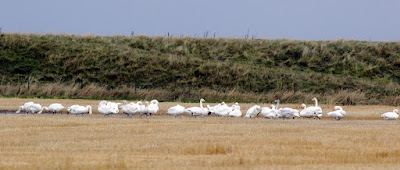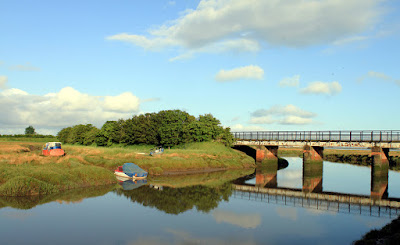There was a sad start to the journey this morning when the car headlights picked out something motionless in the centre of the road near Pilling village. It was a Red Fox that had been hit by a vehicle. When when I looked closer there was fresh and still trickling blood.
It’s an animal I would much rather see alive although I rarely do. Not for us the urban or even rural fox as in this part of Lancashire the Red Fox is controlled mercilessly by gamekeepers and farmers alike. I stopped to take a quick photograph or two as I was on my way to Oakenclough 10 miles away.
Red Fox
I’d missed a couple of ringing sessions but while I was absent Andy caught more Redwings and a handful of Fieldfares. That brought our autumn Redwing total to 48 before today - 41 first year birds and 7 adults, a fairly typical ratio of ages. Although we thought this a pretty good effort, it broke no records.
The morning forecast looked more promising than recent ones so we arranged to meet at 0600. That would give us time to have nets up to await the first arrivals of Redwings, overnight migrants or individuals that had roosted nearby.
Redwing
We caught the first Redwings in the dark and then a few more later in our catch of 39 birds and a mix of 12 species: 10 Greenfinch, 7 Redwing, 6 Blue Tit, 4 Blackbird, 3 Chaffinch, 2 Robin, 2 Coal Tit and then singles of Treecreeper, Dunnock, Great Tit, Goldcrest and Lesser Redpoll.
At this time of year individual Redwings Turdus iliacus cannot be sexed by appearance or size. Redwings of the Icelandic race Turdus iliacus coburni can occasionally be separated out by a combination of their larger size and darker colouration. As yet all of our autumn Redwings have fitted the iliacus pattern with none exhibiting features to suggest a more thorough inspection.
The one pictured below is an obvious first year “iliacus”, easily aged through both the fault bars in the pointy tail and the cream “notches” in the primary feather coverts.
Redwing
Redwing
There was a steady trickle of Redwings until about 0900 hours by which time we had counted about 130 individuals as they arrived from a north-westerly direction.
To catch four new Blackbirds is quite unusual for us here with all proving to be quite large, heavy at about 100 gm and long-winged (126-137 mm). We considered that three of them were recent immigrant Blackbirds.
When British Blackbirds return to gardens in the winter, they are often joined by immigrants. Large numbers of Blackbirds migrate from Scandinavia and continental Europe to spend the winter in Britain and Ireland. Very often these individuals, especially the males are subtly different from our own resident Blackbirds, by amongst other things, their dark bills, sooty plumage and scalloped throat and breast feathers.
Blackbird
There was a noticeable arrival of both Greenfinches and Chaffinches this morning as tiny parties arrived from the north-west throughout our five hour stay. We counted approximately 70 Greenfinches and 50 Chaffinches, a likely underestimate in the always overcast sky and poor visibility.
At this time of year our Greenfinches eat large amounts of the fruit of the rose plant, rose-hip. A giveaway sign is the amount of red residue on their bills.
Greenfinch
Rose hips
Chaffinch
The morning saw a substantial movement of Wood Pigeons consisting of small parties but also two large flocks of c150 and c300 - in all about 540 individuals flying strongly from North West to South East.







































































